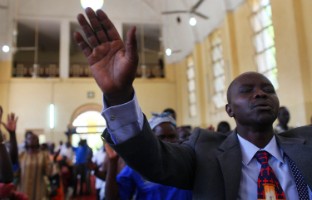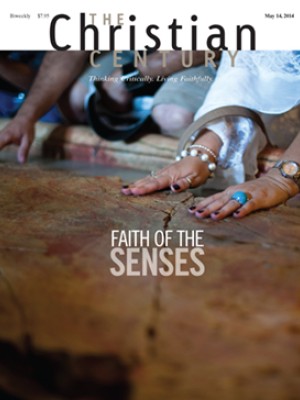Is the church helping? Christians and the conflict in South Sudan

Only two years ago South Sudan was celebrating its independence from the repressive Sudan regime. After 20 years of civil war, a beleaguered yet hopeful people had overcome internal tensions to establish a new state. Churches helped usher in a new era of South Sudan state politics, encouraging participation in the independence referendum and educating South Sudanese on the particulars of voting.
But the spirit of celebration came to an abrupt halt in December 2013 when virulent and sudden violence broke out. At least 10,000 people died, and over 800,000 people were displaced. As the conflict continues, some Christians are resisting the violence while others are complicit in it.
Read our latest issue or browse back issues.
At the center of the crisis are President Salva Kiir and former vice president Riek Machar, both former rebel leaders in Sudan’s civil war. Both men emerged in the 1980s as leaders of the Sudan Peoples Liberation Movement/Army, which fought for southern autonomy from the largely Islamic northern Sudan government. In 1991 Machar, then a senior rebel commander, tried to oust Kiir and SPLM/A chair John Garang from power. When the coup failed, Machar formed his own movement, and brutal conflict ensued.
Raiding between Dinka and Nuer ethnic groups increased dramatically from small tit-for-tat battles to wholesale slaughters like the Bor massacre in 1991, in which a Nuer militia killed thousands and sent many more into the bush. Until then the Dinka and Nuer had always intermarried and shared extensive commercial ties, but now the ethnic markers became fixed and militarized.
Amid the violence of those years, the New Sudan Council of Churches initiated a movement called People-to-People Peacemaking. The process brought together local elders and chiefs, church leaders, and rebel politicians to dialogue about past atrocities, seek restitution, and establish local governance systems to prevent further outbreaks of violence. The movement succeeded in large part because it involved not only rebel politicians but also indigenous kinship leaders who had more influence with many South Sudanese than did rebel politicians.
The process creatively adapted indigenous peace rituals like bull sacrifice with Christian practices of confession and forgiveness to stem the tide of ethnic violence. It led to the Wunlit peace conference in 1999, to the peaceful coexistence of Dinka and Nuer in large areas of South Sudan, to a more cohesive South, and to peace between northern and southern Sudan in 2005. When South Sudan became independent in 2011, churches continued their work of peacemaking: the Sudan Council of Churches and Anglican archbishop Daniel Deng Bul started “Peace from the Roots,” which united church leaders and indigenous elders to lead dialogues for peace.
During Sudan’s civil war, Christianity grew substantially, in part because identification with Christianity was another way to resist northern Sudan. Conversion became a political act. As various rebel leaders split off from one another, pastors often followed suit, employing the trope of ethnicity to gain followers. Denominational boundaries that followed ethnic lines, left over from missions of the colonial era, only exacerbated conflict. These fissures continue to impact the present conflict.
In 2011, when the SPLM/A became the ruling party in the government of South Sudan, a political crisis quickly spread across large parts of the country, with churches swept up in the tide. Violence broke out in the capital city of Juba in December 2013. President Kiir accused Machar of staging a coup and then imprisoned key politicians perceived to be part of the resistance. Powerful militias quickly joined Machar’s side. While Kiir and Machar both speak of transcending ethnic divisions, each manipulated ethnic sentiments to advance political and military aims. The Presidential Guard—largely Dinka—swept through residential districts around Juba, arbitrarily killing Nuer. Meanwhile Nuer militias stormed Dinka territories, stealing cattle and killing soldiers and civilians alike.
Each side has sought to capture as much territory as possible to increase its political advantages and to gain leverage in negotiations. Undisciplined military forces kill indiscriminately, forcing villagers to flee into the bush. Many towns are decimated as local control changes between government and rebel troops.
Again church leaders are seeking to be peacemakers and prophets. Dinka elders and church leaders are working together to encourage reconciliation among factions of the SPLM/A that were openly challenging one another. Catholic archbishop Paulino Lukudu criticized politicians for their failure to reconcile. When violence broke out, church leaders called for an immediate and unconditional end to hostilities—to no avail.
At the local level many Christians have graciously received refugees, held public prayer services for peace, and encouraged hope in weekly preaching. Anglican bishop Joseph Atem, for example, has worked with his local chief and sympathetic political authorities to halt potential outbreaks of violence in their hometown of Renk and to receive refugees from the nearby town of Malakal.
Church leaders have challenged politicians who instigated violence. In a Pastoral Exhortation in January 2014, Catholic bishops charged: “The blood of the innocent, in their thousands, cries out from the ground! The Lord will judge harshly those who continue to murder, rape and loot his innocent children, and even more harshly those who incite this violence and fail to prevent it in their greed for power.”
At the same time, however, other pastors are exacerbating local conflicts. One pastor laments, “Many church leaders are dividing along tribal lines instead of taking up their mantle of peacemaking and reconciliation.” Both Kiir and Machar identify themselves as Christians—Kiir as Catholic, Machar as Presbyterian; some pastors are all too happy to support these politicians in order to gain political and religious prestige.
The church’s ultimate response to the conflict depends on how it navigates its three roles of peacemaker, prophet, and collaborator. The brutalities of the ’90s and its contemporary legacies reveal, on the one hand, that undue accommodation to political movements leads churches to mimic ethnic divisions. On the other hand, the church’s work in peacemaking and prophetic witness shows that it has remarkable resources at its disposal which can help heal the divisions of South Sudan.






